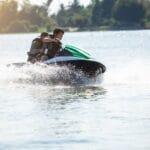This guide provides a comprehensive overview of personal watercraft (PWC) operation, focusing on situations that demand more than just idle speed. We’ll cover everything from maneuvering around docks to understanding the physics behind steering, equipping you with the knowledge and skills to navigate the water safely and confidently.
Maneuvering Your PWC: Beyond Idle
While idling along offers a relaxing experience, many PWC operations require more than a gentle purr from the engine. Essentially, any action demanding control beyond simple drifting necessitates higher speeds.
Essential Maneuvers Requiring Higher Speeds
Docking and Close-Quarters Navigation: Similar to parking a car, navigating tight spaces near docks, ramps, other boats, or swimmers requires precise control, achievable with the increased responsiveness provided by higher speeds. At idle, the minimal water flow over the steering controls (jet pump) hinders precise movements. Learn more about safe boating practices.
Wake Jumping: This exhilarating activity demands sufficient speed to climb the wake’s face and land safely. Attempting a wake jump at idle speed likely results in a nosedive or loss of control due to insufficient momentum.
Overtaking Vessels: Safely passing other boats requires precise speed and directional control, challenging to maintain at idle speed. A burst of speed facilitates quick, efficient passing, minimizing time spent in blind spots.
Handling Challenging Water Conditions: Calm waters may permit idle speed, but chop, currents, or wind necessitates increased speed for greater stability and responsiveness.
Why Speed Matters for Safety
Counterintuitively, maintaining sufficient speed often enhances safety. It empowers quick, decisive maneuvers that prevent accidents. Understanding the limitations of idle speed is crucial for responsible PWC operation.
Future of PWC Operation
Ongoing research explores new hull designs and propulsion systems that may improve low-speed maneuverability. However, until these become widely available, understanding the limitations of idle speed remains critical.
PC Operations and Processing Power
This section clarifies the distinction between PWCs (personal watercraft) and PCs (personal computers) and addresses the question of which PC operations require more than idle speed.
Beyond Idle: When Your PC Needs a Boost
Think of your computer like a car. Idle speed is the bare minimum activity to keep it running. Almost every action, even seemingly simple ones, requires more than idle speed. The intensity of the task dictates how much the CPU ramps up its speed.
Examples of PC Operations and CPU Usage
| Task | CPU Usage (General) |
|---|---|
| Idle | Very Low |
| Web Browsing | Low to Moderate |
| Word Processing | Low |
| Music Playback | Low to Moderate |
| Video Streaming | Moderate to High |
| Gaming | High to Very High |
| Video Editing | Very High |
| 3D Rendering | Very High |
These are estimates; actual usage varies based on software, task complexity, and PC specifications.
Monitoring and Managing CPU Usage
Tools like Task Manager (Windows) or Activity Monitor (macOS) provide real-time insights into CPU usage. Consistently high usage may indicate background processes, malware, or system inefficiencies. Solutions include closing unnecessary applications, updating drivers, malware scans, and system optimization.
Navigating Michigan’s Waterways: PWC Regulations
This section provides a detailed overview of legal requirements for PWC operation in Michigan.
Speed and Distance Regulations
Open Water: Exceeding slow-no-wake speed is generally permitted, but operators must maintain a 150-foot distance behind other vessels (excluding PWCs).
Near Shoreline: Slow-no-wake speed is mandatory within 200 feet of the shoreline, except when entering or exiting perpendicularly.
Near Swimmers: Maintain slow-no-wake speed and a safe distance from swimmers.
| Situation | Legal Speed | Distance Requirement |
|---|---|---|
| Open Water | Greater than slow-no-wake allowed | 150 feet behind other vessels (excluding PWCs) |
| Within 200 feet of shoreline | Slow-no-wake | N/A |
| Near Swimmers | Slow-no-wake | Maintain a safe distance |
| Entering/Exiting Perpendicular to Shore | Greater than slow-no-wake allowed | Exercise extreme caution and maintain a safe distance |
Note: “Slow-no-wake” isn’t necessarily the lowest possible speed, but the slowest speed maintaining steering control.
Time Restrictions and Other Considerations
Nighttime Operation: PWC operation is restricted between sunset and 8:00 am.
Local Ordinances: Be aware of local regulations that may impose stricter rules. For insurance-related information, see this article.
Always consult official Michigan boating regulations for the most current information.
Understanding PWC Steering Mechanics
This section delves into the physics of how a PWC turns.
The Science of a Right Turn
Turning the handlebars right adjusts the steering nozzle, redirecting the water jet. This rightward thrust pushes the stern left, initiating a right turn. It’s a counterintuitive yet fundamental principle of thrust vectoring.
Key Factors Influencing Steering
Speed: Higher speeds amplify the force of the redirected water, resulting in sharper turns.
Steering Input: The degree of handlebar rotation directly affects the turning radius.
Importance of Maintenance and Understanding
Regular maintenance ensures the steering system’s responsiveness and reliability. Understanding these mechanics enhances control, promoting safe and enjoyable PWC operation.
- Unlock Water’s Symbolism: A Cross-Cultural Exploration - April 20, 2025
- Identify Black and White Snakes: Venomous or Harmless? - April 20, 2025
- Unlocking Potential: Origins High School’s NYC Story - April 20, 2025
















1 thought on “Beyond Idle: Essential PWC Operations Requiring More Than Idle Speed”
Comments are closed.